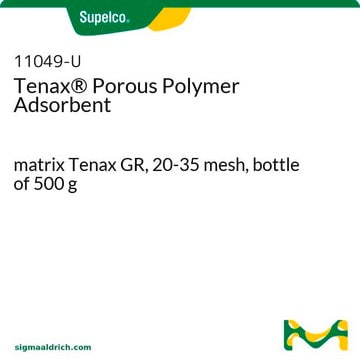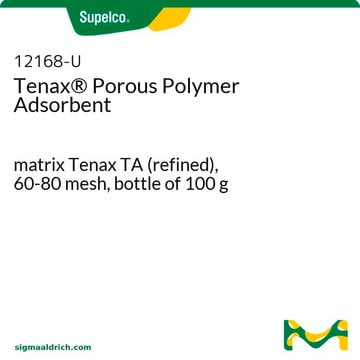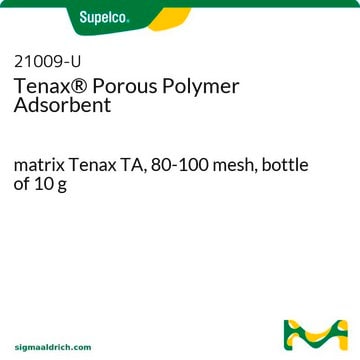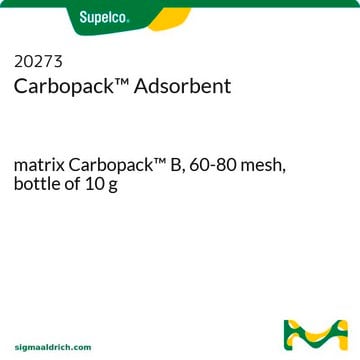Products may be shipped at a different temperature than the recommended long-term storage temperature. If the product quality is sensitive to short-term exposure to conditions other than the recommended long-term storage, it will be shipped on wet or dry-ice. If the product quality is NOT affected by short-term exposure to conditions other than the recommended long-term storage, it will be shipped at ambient temperature. As shipping routes are configured for minimum transit times, shipping at ambient temperature helps control shipping costs for our customers. For more information, please refer to the Storage and Transport Conditions document: https://www.sigmaaldrich.com/deepweb/assets/sigmaaldrich/marketing/global/documents/316/622/storage-transport-conditions-mk.pdf
11982
Adsorbente polimerico poroso Tenax®
matrix Tenax TA, 60-80 mesh, bottle of 10g
About This Item
Prodotti consigliati
Nome del prodotto
Adsorbente polimerico poroso Tenax®, matrix Tenax TA, 60-80 mesh, bottle of 10 g
agenzia
suitable for EPA 601
Stato
solid
Confezionamento
bottle of 10 g
Parametri
350 °C temp. limit
Area superficiale
~35 m2/g
Matrice
Tenax TA
Dimensione particelle
60-80 mesh
Densità
~0.25 g/mL (free fall density)
Cerchi prodotti simili? Visita Guida al confronto tra prodotti
Descrizione generale
Per maggiori informazioni su qualsiasi nostro adsorbente visitare sigma-aldrich.com/adsorbents
Applicazioni
- Composti organici volatili (VOC) in diversi microambienti prima della loro determinazione per desorzione termica a breve raggio (SPTD) e gas cromatografia-spettrometria di massa (GC-MS).[1]
- Idrocarburi C7-C26 in campioni di aria nell′ambiente[2] e VOC in campioni d′aria in ambienti di lavoro[3] prima della loro analisi mediante TD seguita da GC.
Note legali
Avvertenze
Warning
Indicazioni di pericolo
Consigli di prudenza
Classi di pericolo
Eye Irrit. 2 - Skin Irrit. 2 - STOT SE 3
Organi bersaglio
Respiratory system
Codice della classe di stoccaggio
11 - Combustible Solids
Classe di pericolosità dell'acqua (WGK)
WGK 3
Punto d’infiammabilità (°F)
Not applicable
Punto d’infiammabilità (°C)
Not applicable
Dispositivi di protezione individuale
dust mask type N95 (US), Eyeshields, Gloves
Scegli una delle versioni più recenti:
Certificati d'analisi (COA)
It looks like we've run into a problem, but you can still download Certificates of Analysis from our Documenti section.
Se ti serve aiuto, non esitare a contattarci Servizio Clienti
Possiedi già questo prodotto?
I documenti relativi ai prodotti acquistati recentemente sono disponibili nell’Archivio dei documenti.
I clienti hanno visto anche
Contenuto correlato
This page is intended to make it easier to find the consumables you need based on the analytical method you’re using. Methods included on this page come from the EPA, Standard Methods and ASTM.
-
How is shipping temperature determined? And how is it related to the product storage temperature?
1 answer-
Helpful?
-
-
How can I determine the shelf life / expiration / retest date of this product?
1 answer-
If this product has an expiration or retest date, it will be shown on the Certificate of Analysis (COA, CofA). If there is no retest or expiration date listed on the product's COA, we do not have suitable stability data to determine a shelf life. For these products, the only date on the COA will be the release date; a retest, expiration, or use-by-date will not be displayed.
For all products, we recommend handling per defined conditions as printed in our product literature and website product descriptions. We recommend that products should be routinely inspected by customers to ensure they perform as expected.
For products without retest or expiration dates, our standard warranty of 1 year from the date of shipment is applicable.
For more information, please refer to the Product Dating Information document: https://www.sigmaaldrich.com/deepweb/assets/sigmaaldrich/marketing/global/documents/449/386/product-dating-information-mk.pdfHelpful?
-
-
Can tenax be restored in laboratory oven at 40 *C temperature?
1 answer-
The Tenax® Porous Polymer Adsorbent can be regenerated by hot-methanol extraction.
Helpful?
-
-
What is the Department of Transportation shipping information for this product?
1 answer-
Transportation information can be found in Section 14 of the product's (M)SDS.To access the shipping information for this material, use the link on the product detail page for the product.
Helpful?
-
-
What solvents can be used for chemical desorption for Product No. 11982, Tenax TA 60-80 mesh?
1 answer-
Common solvents like alcohols, ethers, hydrocarbons, and aqueous hydrochloric acid/sodium hydroxide can be used. Don't use chlorinated hydrocarbons like dichloromethane, aromatics like xylene and carbon disulfide. All other solvents not mentioned can be used after checking solubility.
Helpful?
-
Active Filters
Il team dei nostri ricercatori vanta grande esperienza in tutte le aree della ricerca quali Life Science, scienza dei materiali, sintesi chimica, cromatografia, discipline analitiche, ecc..
Contatta l'Assistenza Tecnica.











